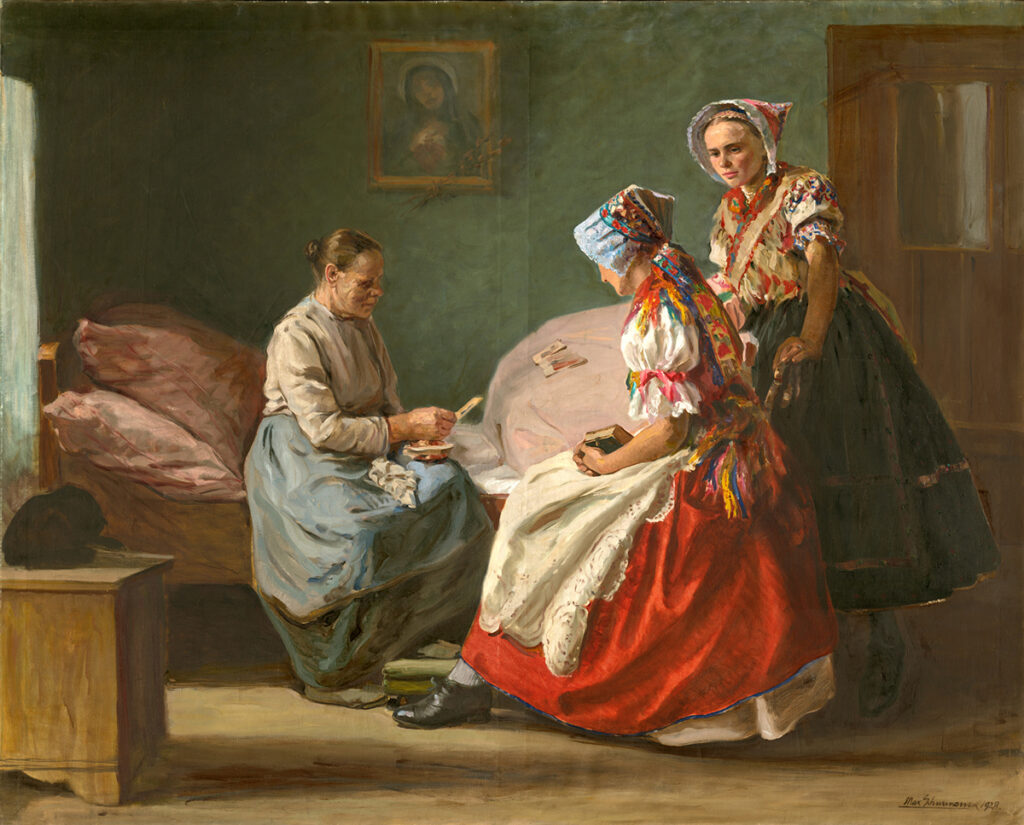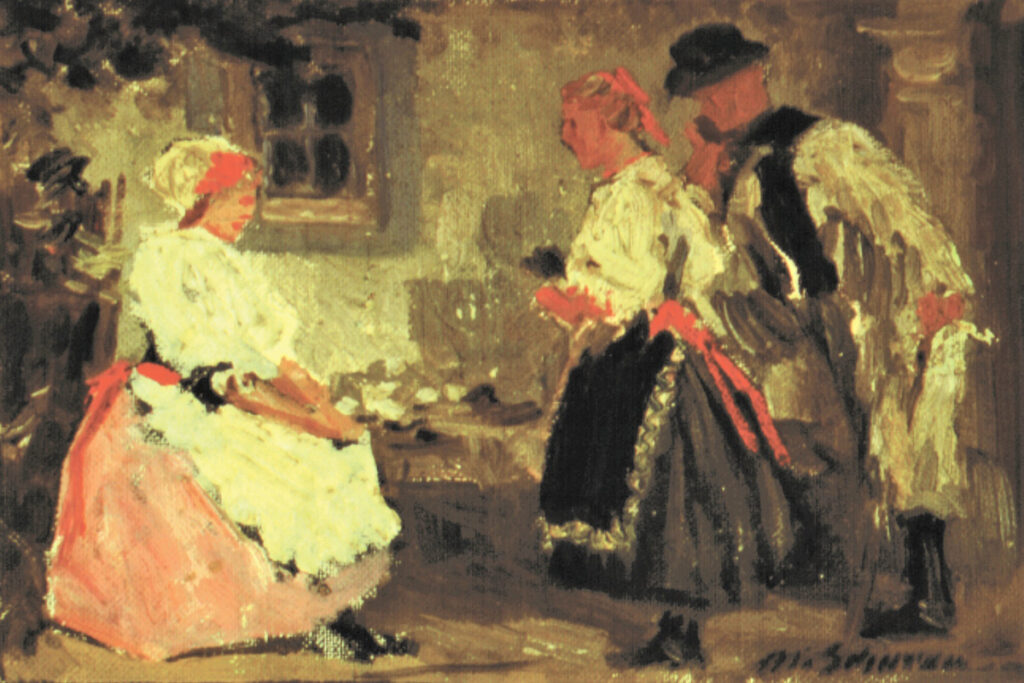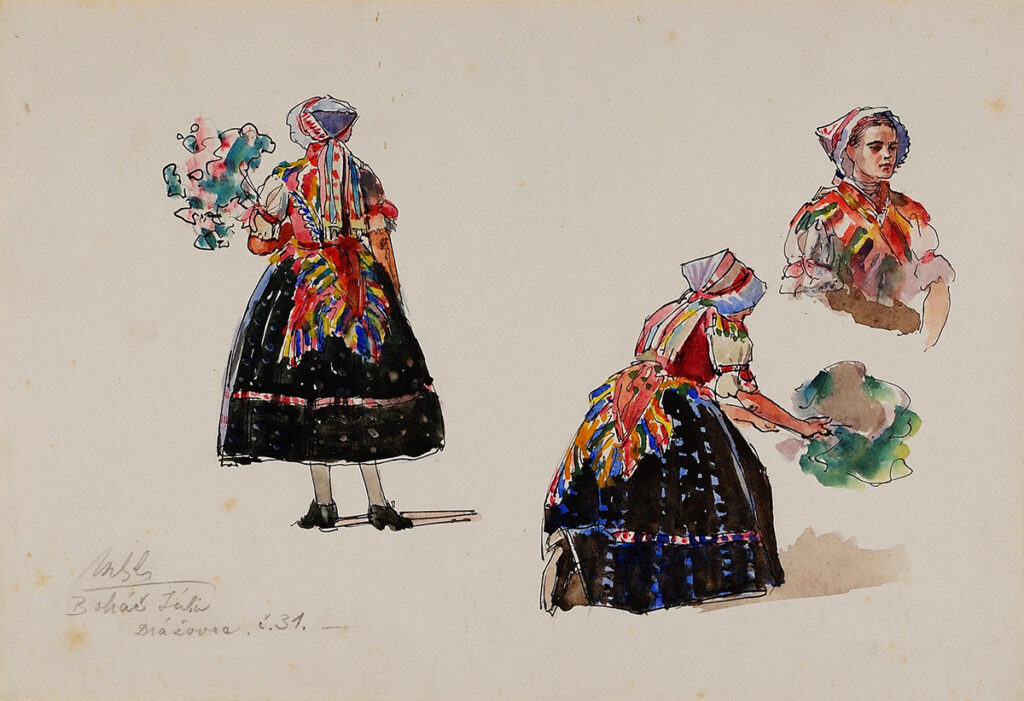The large scale panting titled Women of Dražovce (Inv. No.: O 65) is considered one of the artist’s masterpieces and used to be on a long-term loan at the Bratislava Castle. Schurmann painted it a year before he moved to Bratislava, during a period when Nitra and its surroundings served as the main inspiration of his landscape themes, urban vistas and portraits. The image captures a fortune teller reading cards to two young women wearing Dražovce folk costumes. The masterpiece’s composition incorporates a brilliant use of light and colour and captures the richly decorated costumes in great detail. An interesting element is the symbiosis of religion and magic among the villagers – even though Christianity considers fortune telling a form of witchcraft, there is an image of the Virgin Mary hanging on the wall and one of the women is holding a prayer book. Did they have their fortune told on the way from the Sunday service, just in case? There is also a black cat lying on a nightstand in the left part of the image. Black cats are considered a symbol of sorcery and misfortune in our culture.
The Nitra Gallery collection includes a small oil painting titled Sketch for Women of Dražovce (Inv. No.: O 348). When we compare it with Women of Dražovce, we will find several significant differences: the scene is set outside, rather then inside, the figure of the fortune teller is wearing a folk costume, the woman in the middle is standing and instead of another young woman standing behind her, there is a man there. Therefore, it is not clear whether it really is a preparatory sketch for the painting and why Schurmann changed so many things in the final version.
There is an interesting story related to the Women of Dražovce painting which leads to a speculation whether the artist had some kind of a suspicion of the tragic fate of one of the women. It has been described by Štefan Valent, the first director of Nitra Gallery and Schurmann’s personal friend: “Schurmann had his studio at his parents’ house on Vikárska Street, not far from the Nitrička River where a fortune teller lived. She would be visited mostly by young women. At that time, it was not uncommon to see girls in folk costumes from the nearby Dražovce. On the occasion of the gallery’s tenth anniversary, there was an exhibition showcasing selected pieces from the institution’s collection fund. […] A predominant feature of the exhibition was Schurmann’s Women of Dražovce. One day, after hours, our custodian came to me somewhat shaken, saying there is an older man with two young women crying in front of the Women of Dražovce painting. […] At the time the image was made, the man was married to the beautiful woman from Dražovce standing in front of the sitting fortune teller. Now, he was a widower of the deceased woman from Dražovce and the two young women next to him were her daughters. They were upset by the unforgettable memory of the young woman of Dražovce, a wife and mother, who had died from typhus in the fall.”[1]
The third image from the Nitra Gallery’s collection (Inv. No. O 357) might help with the woman’s identification. It depicts a young woman wearing a folk costume from different points of view. There is the following text under the artist’s signature: „Boháč Júlia, Drážovce č. 31.“ It would seem the woman might actually be Júlia Verešová, born Boháčová (living at the address Dražovce 84), a wife and mother of two daughters, who died when she was 28 on October 26, 1934 in Dražovce from typhus. Another image by Maximilián Schurmann titled Dying Woman, which is in the Bojnice Castle’s collection, supposedly captures her last moments…[2]
Maximilián Schurmann (August 29, 1890, Štvrtok na Ostrove – March 24, 1960, Bratislava)
His civil name was Max Raimund von Geher and he was an illegitimate son of Raimund Wichera, the Knight of Brennerstein, a court painter of the emperor Francis Joseph I., and Paulína von Geher who worked for Count Esterházy and later married Július Schurmann. From 1907 to 1914, he studied at the Academy of Fine Arts in Vienna where he received multiple awards. He also studied at the Académie Julian in Paris where met the famous impressionist Claude Monet – he would actually paint in the garden at his studio in Giverny. During World War I, due to his foreign citizenship, he was sent to a monastery in the French town of Espalion near Avignon, where he could, however, spend his time working on portraits and sketches. After the war, he would move between Nitra and Paris – where he married a widow Martha Laurent. In 1921, he was one of the co-founders of the Slovak Art Forum. From 1925 to 1931, he led a private painting school in Nitra. Due to a lack of orders, he moved from Nitra to Bratislava in 1929, but he kept his studio at his parents’ house and used it often for painting. In Bratislava, he taught at the Slovak University of Technology. From 1939, he was an associate professor of painting and from 1941 to 1945, he worked there as a special professor at the department of drawing and painting. His work focused on landscapes and urban vistas, still life and portraits. Nitra Gallery holds the largest collection of Maximilián Schurmann’s works in Slovakia.
— Omar Mirza
Notes
[1] VALENT, Štefan: Obraz Dražovčanky M. Schurmanna. [The Painting of Women of Dražovce] In: Zo spomienok Nitranov [From the Memories of the People of Nitra]. Originál – mesačník Ponitrianskej galérie v Nitre [Original – Nitra Gallery’s Monthly Magazine], Vol. 8, Year V., 1998, p. 6, quoted from: HUČKOVÁ, Marta: Maximilián Schurmann (1890 – 1960) – kresba, grafika, akvarel [Maximilián Schurmann (1890 – 1960) – painting, printmaking, aquarelle]. Nitra: Nitra Gallery, 2010, p. 25 – 26, ISBN 978-80-85746-47-1. [2] See: https://www.facebook.com/notes/bojnicecastle/maximili%C3%A1n-schurmann-umieraj%C3%Baca/1753307014713853/ (Accessed On: March 17, 2021).
Bibliography
ADAMUSOVÁ, Dagmar: Maximilián Schurmann (1890 – 1960). Nitra: Nitra Gallery, 2000. ISBN 978-80-85746-19-0.
HUČKOVÁ, Marta: Maximilián Schurmann (1890 – 1960) – kresba, grafika, akvarel [Maximilián Schurmann (1890 – 1960) – painting, printmaking, aquarelle]. Nitra: Nitra Gallery, 2010. ISBN 978-80-85746-47-1.
HUČKOVÁ, Marta: Spomienky na Štefana Valenta (1908 – 2007) [Remembering Štefan Valent (1908 – 2007)]. Nitra: Nitra Gallery, 2009. ISBN 978-80-85746-42-6.
No.: O 65
Artist: Maximilián Schurmann
Title: Women of Dražovce
Year of origin: 1928
Technique: oil
Material: canvas
Dimensions: height 190 cm; width 236 cm
Signature: bottom right, in brush: Max Schurmann 1928
No.: O 348
Artist: Maximilián Schurmann
Title: Sketch for Women of Dražovce
Year of origin: 1927 – 1928
Technique: oil
Material: canvas
Dimensions: height 22 cm; width 33 cm
Signature: bottom right, in brush: M. Schurmann
No.: O 357
Artist: Maximilián Schurmann
Title: Women of Dražovce Study
Year of origin: 1927 – 1928
Technique: gouache
Material: paper
Dimensions: height 21 cm; width 31 cm
Signature: bottom right, in pencil: M Sch


